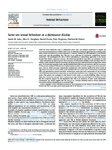Same-sex sexual behaviour as a dominance display
| dc.contributor.author | Lane, Sarah | |
| dc.contributor.author | Haughan, AE | |
| dc.contributor.author | Evans, D | |
| dc.contributor.author | Tregenza, T | |
| dc.contributor.author | House, CM | |
| dc.date.accessioned | 2018-10-24T14:09:15Z | |
| dc.date.available | 2018-10-24T14:09:15Z | |
| dc.date.issued | 2016-04 | |
| dc.identifier.issn | 0003-3472 | |
| dc.identifier.issn | 1095-8282 | |
| dc.identifier.uri | http://hdl.handle.net/10026.1/12630 | |
| dc.description.abstract |
Same-sex sexual behaviour (SSB) is widespread across taxa. One adaptive hypothesis to explain the occurrence and maintenance of SSB is that it acts to intensify or diminish aggression by providing males with a means to reinforce or resolve dominance. However, evidence for this hypothesis is very limited across taxa and the possibility that SSB acts as an extension of intrasexual competition remains contentious. We investigated the role of SSB in intensifying or diminishing aggression in the broad-horned flour beetle, Gnatocerus cornutus. We tested the hypothesis that SSB is an extension of male-male competition by observing how the occurrence of SSB and the stability of SSB courtship roles (i.e. whether males switched between mounting and being mounted) influenced levels of aggression within pairs. We found that, typically, males rapidly establish fixed SSB roles and moreover that the occurrence of SSB and the stability of SSB roles had a highly significant effect on levels of aggression observed within pairs. Pairs in which one male consistently mounted the other showed significantly lower levels of aggression than pairs in which neither male exhibited SSB or in which males continuously switched SSB roles and attempted to mount each other. Furthermore, males that were consistently on the receiving end of SSB demonstrated lower propensity to court females and had a lower mating success than active males. This pattern was analogous to that found in loser males as a result of fighting. Males that lost fights also courted less and had lower mating success than males that won fights. Our findings provide the first empirical support for the hypothesis that SSB is an extension of male-male competition. Furthermore, our results suggest that SSB may act as a display, allowing males to resolve dominance hierarchies without escalating into an injurious fight. | |
| dc.format.extent | 113-118 | |
| dc.language | en | |
| dc.language.iso | en | |
| dc.publisher | Elsevier BV | |
| dc.subject | aggression | |
| dc.subject | courtship | |
| dc.subject | dominance | |
| dc.subject | Gnatocerus cornutus | |
| dc.subject | male mating success | |
| dc.subject | male-male contests | |
| dc.subject | noninjurious display | |
| dc.subject | same-sex sexual behaviour | |
| dc.title | Same-sex sexual behaviour as a dominance display | |
| dc.type | journal-article | |
| dc.type | Journal Article | |
| plymouth.author-url | https://www.webofscience.com/api/gateway?GWVersion=2&SrcApp=PARTNER_APP&SrcAuth=LinksAMR&KeyUT=WOS:000373375100016&DestLinkType=FullRecord&DestApp=ALL_WOS&UsrCustomerID=11bb513d99f797142bcfeffcc58ea008 | |
| plymouth.volume | 114 | |
| plymouth.publication-status | Published | |
| plymouth.journal | Animal Behaviour | |
| dc.identifier.doi | 10.1016/j.anbehav.2016.01.005 | |
| plymouth.organisational-group | /Plymouth | |
| plymouth.organisational-group | /Plymouth/Faculty of Science and Engineering | |
| plymouth.organisational-group | /Plymouth/Faculty of Science and Engineering/School of Biological and Marine Sciences | |
| plymouth.organisational-group | /Plymouth/Users by role | |
| plymouth.organisational-group | /Plymouth/Users by role/Academics | |
| dc.identifier.eissn | 1095-8282 | |
| dc.rights.embargoperiod | Not known | |
| rioxxterms.versionofrecord | 10.1016/j.anbehav.2016.01.005 | |
| rioxxterms.licenseref.uri | http://www.rioxx.net/licenses/all-rights-reserved | |
| rioxxterms.type | Journal Article/Review |


